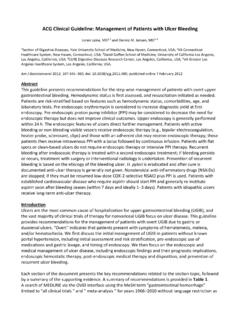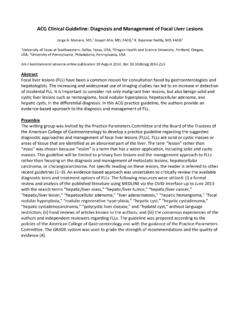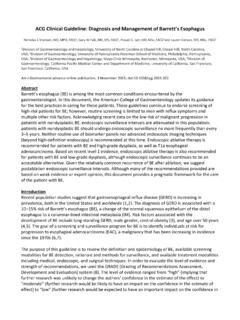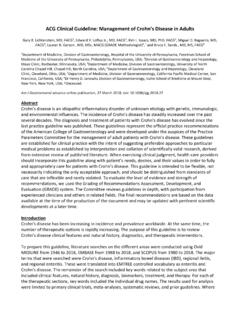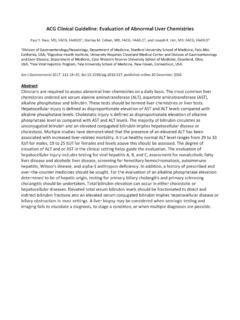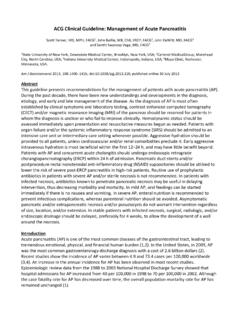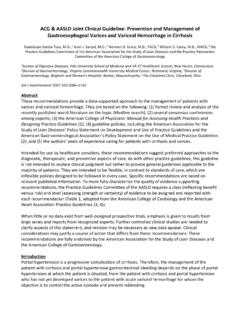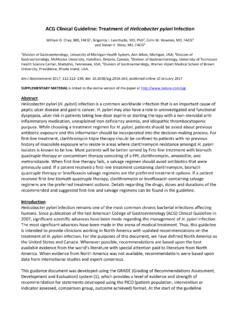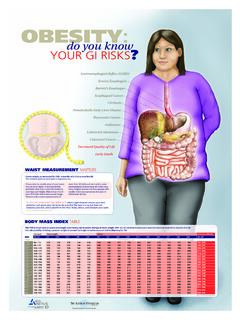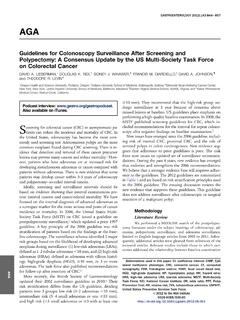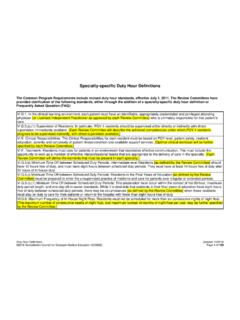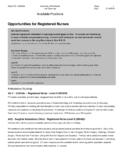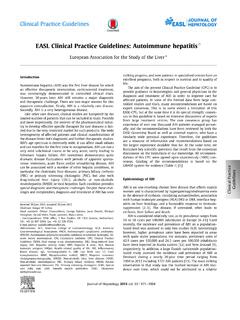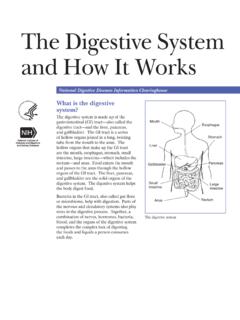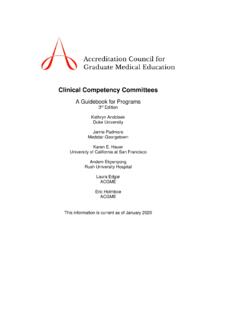Transcription of ACG Clinical Guideline: Diagnosis and Management of ...
1 ACG Clinical Guideline: Diagnosis and Management of Pancreatic Cysts Grace H. Elta , MD, FACG1 , Brintha K. Enestvedt , MD, MBA2 , Bryan G. Sauer , MD, MSc, FACG (GRADE Methodologist)3 and Anne Marie Lennon , MD, PhD, FACG4 1 Division of Gastroenterology, University of Michigan Medical Center, Ann Arbor, Michigan, USA ; 2 Division of Gastroenterology, Oregon Health and Sciences University, Portland, Oregon, USA ; 3 Division of Gastroenterology, University of Virginia, Charlottesville, Virginia, USA ; 4 Division of Gastroenterology, The Johns Hopkins Medical Institutions, Baltimore, Maryland, USA Am J Gastroenterol advance online publication, 27 February 2018; doi: Abstract Pancreatic cysts are very common with the majority incidentally identified.
2 There are several types of pancreatic cysts; some types can contain cancer or have malignant potential, whereas others are benign. However, even the types of cysts with malignant potential rarely progress to cancer. At the present time, the only viable treatment for pancreatic cysts is surgical excision, which is associated with a high morbidity and occasional mortality. The small risk of malignant transformation, the high risks of surgical treatment, and the lack of high-quality prospective studies have led to contradictory recommendations for their immediate Management and for their surveillance. This guideline will provide a practical approach to pancreatic cyst Management and recommendations for cyst surveillance for the general gastroenterologist.
3 Introduction Pancreatic cysts are often detected on abdominal imaging performed for non-pancreatic indications. Their prevalence in an asymptomatic population is reported from to with increasing incidence with age (1). A review of abdominal magnetic resonance imaging (MRIs) performed for non-pancreatic indications in patients over the age of 70 showed a 40% incidence of incidental pancreatic cysts (2). Somewhat reassuring is the low prevalence of cysts >2 cm; in 25,195 subjects in five studies the prevalence of cysts >2 cm was only (3). Pancreatic cysts are increasingly being diagnosed because of the use of more abdominal imaging and to the increased quality of that imaging. The overall incidence of pancreatic cancer-related mortality is fairly stable; thus, the increasing incidence of cysts is likely due to the increase in diagnostic scrutiny (4).
4 Some pancreatic cysts have the potential for malignant transformation to invasive ducal adenocarcinoma of the pancreas, hence the cause for concern. The exact risk of malignant transformation is unclear; however, when considering all individuals with pancreatic cysts, the potential risk for malignant transformation is small (5). Using the assumption that all pancreatic cancer arises in patients within pancreatic cysts, an analysis of the SEER database found the probability that a cyst harbors malignancy at the time of imaging is , with the overall conversion rate to invasive cancer being per year (3). However, retrospective series of surgically resected cysts have reported higher rates, with the pooled proportion of cysts with pancreatic cancer of 15% in 27 studies of 2,796 patients (3).
5 The approach of including all pancreatic cysts has been criticized, as many pancreatic cysts have no malignant potential (6,7). When only intraductal papillary mucinous neoplasms (IPMNs) are included, a review of 99 studies of 9,249 patients with IPMNs who underwent surgical resection found that the incidence of either high-grade dysplasia or pancreatic cancer was 42% (ref. 3). The data evaluating the long-term risk of an IPMN developing pancreatic cancer are also contradictory. One review of 3,980 patients with suspected IPMNs reported an overall risk of developing pancreatic cancer of (95% confidence interval (CI), ), which was consistent with an estimated risk of developing pancreatic cancer of per year (95% CI, ) (3).
6 In contrast, a recent systematic review and metaanalysis of 3,236 patients divided IPMNs into low and high risk, the latter being defined as the presence of a mural nodule or dilated main pancreatic duct. They reported a pooled cumulative incidence of high-grade dysplasia or pancreatic cancer of (95% CI, ) at 1 year, (95% CI, ) at 5 years, and (95% CI, ) at 10 years for low-risk IPMNs. The pooled cumulative incidence was (95% CI, ) at 1 year, (95% CI, ) at 5 years, and (95% CI, ) at 10 years for high-risk IPMNs (8). Large, prospective, multicenter studies following cysts that are presumed to be mucinous are required to answer the critical question of the cumulative risk of high-grade dysplasia or cancer.
7 Management decisions for pancreatic cysts must take into account their low risk of malignancy vs. their frequent detection. The cost of cyst analysis and cyst surveillance is high, and the benefit in terms of cancer prevention is unproven. There have been no dedicated cost effectiveness analyses about surveillance of incidental pancreatic cysts. The risks of pancreatic surgery are relatively high. A recent review of the literature suggests that the mortality rate from pancreatic resection for pancreatic cysts is with a morbidity rate of 30% (3). Large worrisome cysts are more commonly found in elderly individuals with comorbidities. Individual life expectancy and risk of death from other factors must be carefully considered in analyzing the risks that pancreatic cysts pose.
8 This guideline will review the various types of pancreatic cysts (Table 1), address common Clinical questions regarding their Management , and provide guidance on when to refer for further evaluation by using a combination of a systematic review of the literature and expert recommendations (Figure 1). The guideline does not apply to patients with strong family history of pancreatic cancer or genetic mutations known to predispose to pancreatic cancer Table 1. Summary and strength of recommendations Pancreatic cyst Diagnosis 1. We recommend caution when attributing symptoms to a pancreatic cyst. The majority of pancreatic cysts are asymptomatic and the nonspecific nature of symptoms requires Clinical discernment (Conditional recommendation, very low quality of evidence) 2.
9 Magnetic resonance imaging (MRI) or magnetic resonance cholangiopancreatography (MRCP) are the tests of choice because of their non-invasiveness, lack of radiation, and greater accuracy in assessing communication between the main pancreatic duct and the cyst (which is a characteristic of side-branch IPMNs). Pancreatic protocol computed tomography (CT) or endoscopic ultrasound (EUS) are excellent alternatives in patients who are unable to undergo MRI. Indeterminate cysts may benefit from a second imaging modality or cyst fluid analysis via EUS (Conditional recommendation, very low quality of evidence) 3. Use caution when using imaging to diagnose cyst type or concomitant malignancy; the accuracy of MRI or MRCP in diagnosing cyst type is 40 50% and in determining benign vs.
10 Malignant is 55 76%. The accuracy for CT and EUS without FNA is similar (Conditional recommendation, very low quality of evidence) Table 1. Summary and strength of recommendations continued Pancreatic cyst Management 4. Patients who are not medically fi t for surgery should not undergo further evaluation of incidentally found pancreatic cysts, irrespective of cyst size (Strong recommendation, low quality of evidence) 5. Patients with asymptomatic cysts that are diagnosed as pseudocysts on initial imaging and Clinical history, or that have a very low risk of malignant transformation (such as serous cystadenomas) do not require treatment or further evaluation (Conditional recommendation, low quality of evidence) 6.
